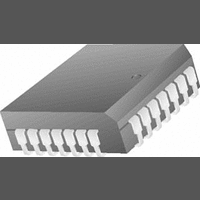ADC0809CCV National Semiconductor, ADC0809CCV Datasheet - Page 5

ADC0809CCV
Manufacturer Part Number
ADC0809CCV
Description
ADC Single SAR 10KSPS 8-Bit Parallel 28-Pin PLCC Rail
Manufacturer
National Semiconductor
Datasheet
1.ADC0809CCV.pdf
(16 pages)
Specifications of ADC0809CCV
Package
28PLCC
Resolution
8 Bit
Sampling Rate
10 KSPS
Architecture
SAR
Number Of Adcs
1
Number Of Analog Inputs
8
Digital Interface Type
Parallel
Input Type
Voltage
Polarity Of Input Voltage
Unipolar
No. Of Pins
28
Peak Reflow Compatible (260 C)
No
Leaded Process Compatible
No
Package / Case
28-PLCC
Rohs Compliant
No
Available stocks
Company
Part Number
Manufacturer
Quantity
Price
Company:
Part Number:
ADC0809CCV
Manufacturer:
Texas Instruments
Quantity:
10 000
Part Number:
ADC0809CCV
Manufacturer:
NS/国半
Quantity:
20 000
Company:
Part Number:
ADC0809CCV/NOPB
Manufacturer:
Texas Instruments
Quantity:
10 000
Company:
Part Number:
ADC0809CCVX
Manufacturer:
Texas Instruments
Quantity:
10 000
Part Number:
ADC0809CCVX
Manufacturer:
TI/德州仪器
Quantity:
20 000
Company:
Part Number:
ADC0809CCVX/NOPB
Manufacturer:
Texas Instruments
Quantity:
10 000
Functional Description
MULTIPLEXER
The device contains an 8-channel single-ended analog signal
multiplexer. A particular input channel is selected by using the
address decoder. Table 1 shows the input states for the ad-
dress lines to select any channel. The address is latched into
the decoder on the low-to-high transition of the address latch
enable signal.
CONVERTER CHARACTERISTICS
The Converter
The heart of this single chip data acquisition system is its 8-
bit analog-to-digital converter. The converter is designed to
give fast, accurate, and repeatable conversions over a wide
range of temperatures. The converter is partitioned into 3 ma-
jor sections: the 256R ladder network, the successive ap-
proximation register, and the comparator. The converter's
digital outputs are positive true.
The 256R ladder network approach (Figure 1) was chosen
over the conventional R/2R ladder because of its inherent
monotonicity, which guarantees no missing digital codes.
Monotonicity is particularly important in closed loop feedback
control systems. A non-monotonic relationship can cause os-
cillations that will be catastrophic for the system. Additionally,
the 256R network does not cause load variations on the ref-
erence voltage.
SELECTED ANALOG
TABLE 1. Analog Channel Selection
CHANNEL
IN0
IN1
IN2
IN3
IN4
IN5
IN6
IN7
C
H
H
H
H
L
L
L
L
ADDRESS LINE
B
H
H
H
H
L
L
L
L
A
H
H
H
H
L
L
L
L
5
The bottom resistor and the top resistor of the ladder network
in Figure 1 are not the same value as the remainder of the
network. The difference in these resistors causes the output
characteristic to be symmetrical with the zero and full-scale
points of the transfer curve. The first output transition occurs
when the analog signal has reached +½ LSB and succeeding
output transitions occur every 1 LSB later up to full-scale.
The successive approximation register (SAR) performs 8 it-
erations to approximate the input voltage. For any SAR type
converter, n-iterations are required for an n-bit converter. Fig-
ure 2 shows a typical example of a 3-bit converter. In the
ADC0808, ADC0809, the approximation technique is extend-
ed to 8 bits using the 256R network.
The A/D converter's successive approximation register (SAR)
is reset on the positive edge of the start conversion start pulse.
The conversion is begun on the falling edge of the start con-
version pulse. A conversion in process will be interrupted by
receipt of a new start conversion pulse. Continuous conver-
sion may be accomplished by tying the end-of-conversion
(EOC) output to the SC input. If used in this mode, an external
start conversion pulse should be applied after power up. End-
of-conversion will go low between 0 and 8 clock pulses after
the rising edge of start conversion.
The most important section of the A/D converter is the com-
parator. It is this section which is responsible for the ultimate
accuracy of the entire converter. It is also the comparator drift
which has the greatest influence on the repeatability of the
device. A chopper-stabilized comparator provides the most
effective method of satisfying all the converter requirements.
The chopper-stabilized comparator converts the DC input sig-
nal into an AC signal. This signal is then fed through a high
gain AC amplifier and has the DC level restored. This tech-
nique limits the drift component of the amplifier since the drift
is a DC component which is not passed by the AC amplifier.
This makes the entire A/D converter extremely insensitive to
temperature, long term drift and input offset errors.
Figure 4 shows a typical error curve for the ADC0808 as
measured using the procedures outlined in AN-179.
www.national.com












